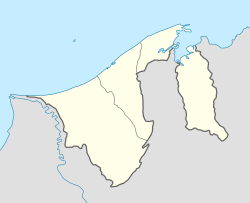Kampong Masin
 From Wikipedia - Reading time: 6 min
From Wikipedia - Reading time: 6 min
Masin | |
|---|---|
| Kampong Masin | |
 Masin Primary School | |
| Coordinates: 4°50′07″N 114°50′40″E / 4.8354°N 114.8445°E | |
| Country | Brunei |
| District | Brunei-Muara |
| Mukim | Pengkalan Batu |
| Government | |
| • Village head | Moksin Kamis[1] |
| Population (2016)[2] | |
• Total | 2,891 |
| Time zone | UTC+8 (BNT) |
| Postcode | BH2723 |
Kampong Masin (Malay: Kampung Masin) or simply known as Masin, is a village in Brunei-Muara District, Brunei, about 15.5 kilometres (9.6 mi) from the capital Bandar Seri Begawan. The population was 2,891 in 2016.[2] It is one of the villages within Mukim Pengkalan Batu. The postcode is BH2723.[3]
Etymology
[edit]According to folktales, a well was found located on a hill in Simpang 616, Jalan Kecil Masin. The water from the well tastes salty. There is also an area where a rice plantation exist. It is impossible that the well felt salty because it was located on a hill, due to this uniqueness, the name of this village is known as Kampong Masin.[4]
Geography
[edit]As a subdivision, Kampong Masin shares boundaries with Kampong Bebatik to the north and north-west, Kampong Kilanas and Kampong Bengkurong to the north-east, Kampong Sinarubai and Kampong Burong Lepas to the east, Kampong Junjongan to the south-east, Kampong Parit to the south and south-east, and Kampong Batong to the west.[5]
Economy
[edit]The Ministry of Industry and Primary Resources' Department of Agriculture and Agrifood issued a call for bids in 2011 to create a development master plan for converting the Batampu Agricultural Development Area into high-tech farming with a leasing system. This 480-hectare property, which was split up into 219 two-hectare lots, was underutilized because it was prone to floods. The goal of the research was to develop both immediate and long-term plans for turning the region into a high-tech farm that used progressive and sustainable farming practices.[6]
Infrastructure
[edit]The village has access to basic facilities provided by the Government of Brunei such as water supply, electricity supply, telephone and roads.[4]
Education
[edit]- Masin Primary School is the village primary school.
- Masin Religious School is the village school for the country's Islamic religious primary education.
- Masin Secondary School is the secondary school for Mukim Pengkalan Batu.
Mosque
[edit]Kampong Masin Mosque is the village mosque; it was inaugurated by the then Minister of Religious Affairs on 27 December 1987.[7] The mosque can accommodate 500 worshippers.[7]
References
[edit]- ^ BUKU DIREKTORI TELEFON PENGHULU-PENGHULU MUKIM DAN KETUA-KETUA KAMPUNG NEGARA BRUNEI DARUSSALAM (PDF) (in Malay). Vol. 4. Brunei: Bahagian Perancangan Daerah, Ministry of Home Affairs. April 2024. p. 15.
- ^ a b "Population and Housing Census Update Final Report 2016" (PDF). www.deps.gov.bn. Department of Statistics. December 2018. Retrieved 5 July 2021.
- ^ "Buku Poskod Edisi Kedua (Kemaskini 26 Disember 2018)" (PDF). post.gov.bn (in Malay). Brunei Postal Services Department. 26 December 2018. Retrieved 18 July 2021.
- ^ a b KOMPILASI RENCANA KNK 2014 (PDF) (in Malay). Kenali Negera Kitani. 2014. pp. 93–98.
- ^ "Geoportal - Survey Department". survey.gov.bn. Retrieved 29 August 2018.
- ^ BRUNEI MUARA DISTRICT PLAN. Bandar Seri Begawan: Department of Town and Country Planning, Ministry of Development. January 2015. pp. 3-37.
- ^ a b "SenaraiMasjid - Masjid Kampong Masin". www.kheu.gov.bn (in Malay). Retrieved 12 January 2018.
 KSF
KSF